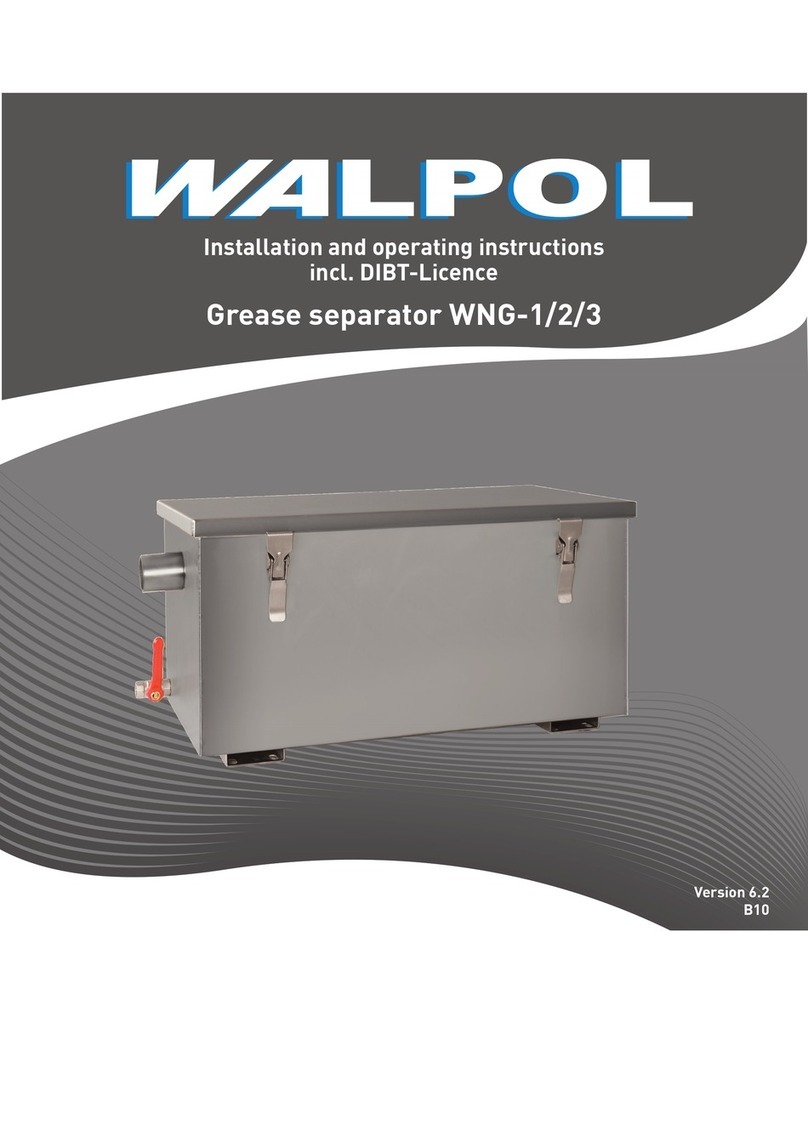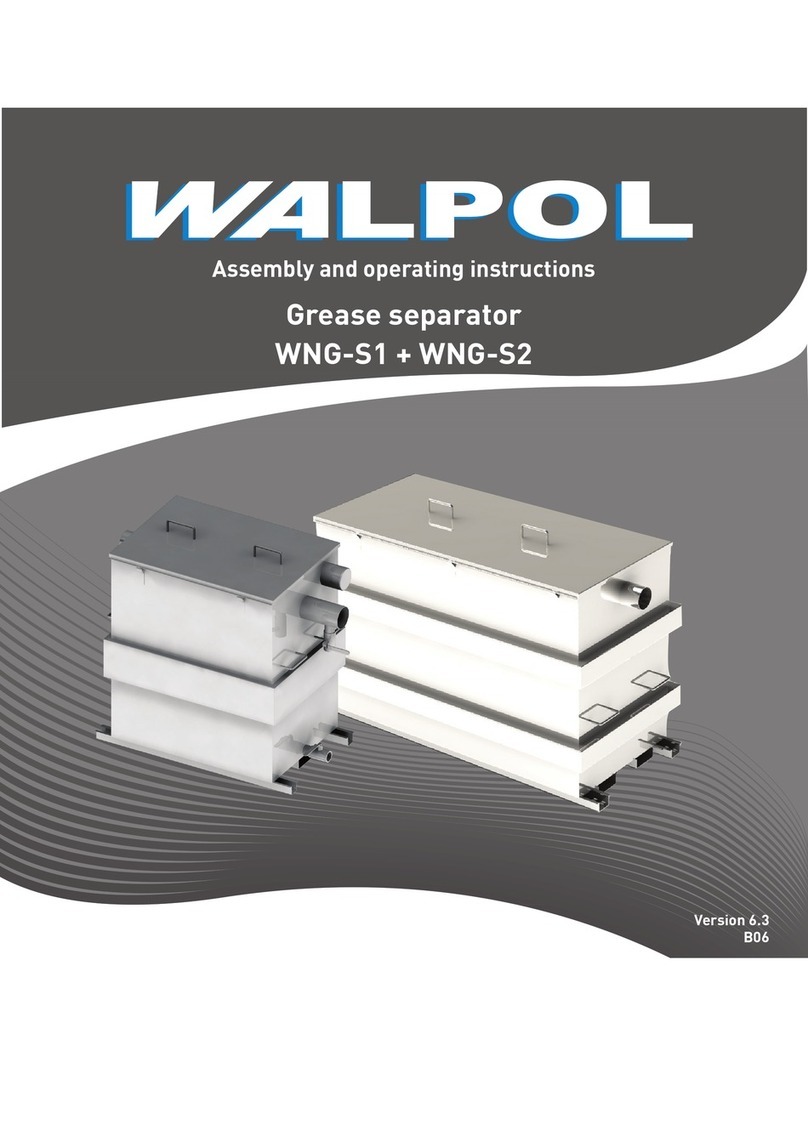
7
5. Description
5.1. Grease separator WNG-S1/S2
A grease separator is used wherever greasy wastewater is to be expected. The grease separator separates fats, oils and
sludge from the wastewater. Thanks to the flushing and disposal device, the grease separator can be disposed of with
almost no odor nuisance, since the odor-tight closed system does not have to be opened for this. The hose of the disposal
vehicle can be connected to the permanently installed disposal line, which is led to an easily accessible point. The separa-
ted fats are pumped directly into the disposal vehicle. This eliminates the time-consuming and unhygienic laying out of the
disposal hoses through utility and storage rooms (e.g. food areas). In addition, there is no odor nuisance there
5.2. Specifications of the grease separator
Typ WNG-S1
Sludge trap 100 liter
Grease separation capacity 120 liter
Weight 103kg
600
1150
850
1015
easy transport with
pallet truck
Intake
DN 100
Drainage
Connection possibility
for venting
Outlet DN 100
Drainage
Typ WNG-S2
Sludge trap 200 liter
Grease separation capacity 482 liter
Weight 143kg
1790
1688
1020
1490690
easy transport with
pallet truck
Intake
DN 100
Drainage
Connection possibility
for venting
Outlet DN 100
Drainage
5.3. Intended Use
The separator system is intended exclusively for the separation of saponifiable oils and fats of vegetable and animal origin.
Any use going beyond this is considered improper. The manufacturer is not liable for any resulting damage; the user alone
bears the risk!
Animal and vegetable oils and fats must not be discharged into public waste disposal facilities or waters, as they cause
cross-sectional constrictions and blockages in the disposal lines when cold. Furthermore, after a short decomposition
time, fatty acids are formed, which lead to unpleasant odors and attack pipes and structures in the drainage system. The
solidified layer of fat on the surface of the water also inhibits the necessary oxygen supply in waters and sewage treatment
plants. In addition, DIN1986 Part 1 requires the retention of harmful substances. For these reasons, grease separator sys-
tems must be provided that must be disposed of accordingly. The temperature in the separator should be as low as possib-
le. With an increase of 10 ° C the separation efficiency is halved.
Compliance with the operating, maintenance and repair conditions prescribed by the manufacturer is also part of the inten-
ded use.
6. Installation
6.1. Installation site / requirements
Free-standing installation in frost-free rooms
Before installing the grease separator, check the following:
Separation systems should be installed near where the waste water occurs. Furthermore, the suction connection for clea-
ning vehicles should be easily accessible.
• The system should not be set up in the vicinity of common rooms, especially not in the vicinity of windows or ventilation
openings, so that unpleasant smells are avoided
• It is easy to reach for cleaning vehicles
• Room with good air circulation and / or ventilation as well as an even and sufficiently stable installation surface
(observe stability / ceiling load)
• Room temperature at least 15°C.
• Sealed floor covering with integrated drainage point.
• Hot and cold water connection
• Room height at least 60 cm higher than the grease separator system, so that the revision lid can be opened during
cleaning work.
• Free working space, at least 1 m, in front of the grease separator system.
• The wastewater is to be fed to the separator system for grease in a free gradient
• Inlet with calming section of min. 1 m (slope 1:50). Transition from on-site downpipe to the calming section equipped
with 2x 45° bends DN 250 at least
• If the supply line is longer than 10 m, it must be vented separately.
• Foreign objects (cutlery, crown corks, mustard bags, bones, etc.) interfere with the separation process
• In areas at risk of flooding, the system can be secured against floating
6.2. Mounting
• Install inlet and outlet
• Establish pipe connections to the house installation at the inlet and outlet.
• Make sure that the seals are sufficiently greased.
• The pipe materials used should be resistant to animal and vegetable fats, oils and their degradation products (seal
made of NBR, high temperatures).
Immediately at the outlet of the separator and before mixing with other wastewater, a device for sampling and inspection
must be installed (depending on the version already included in the scope of delivery)
The sampling point or facility of the separator system must be freely accessible and arranged in such a way that only
wastewater that has passed through the separator system is sampled
6.3. Backflow-free installation
Separator systems for fats whose still water level is below the backflow level must be drained via downstream lifting
systems
• Where aplicable mount the direct disposal pipe - The disposal pipe provided for emptying should have a diameter of at
least 50 mm inside width
• The choice of the pipe material for the disposal line should be based on the waste water content (extremely high solid
content) and the particular operating situation (overpressure / underpressure).
• The disposal line from the grease separator to the transfer point to the disposal vehicle should be laid with a steadily
rising gradient. Changes in the direction of the line through 90 ° bends should be carried out with a large radius if
possible





























